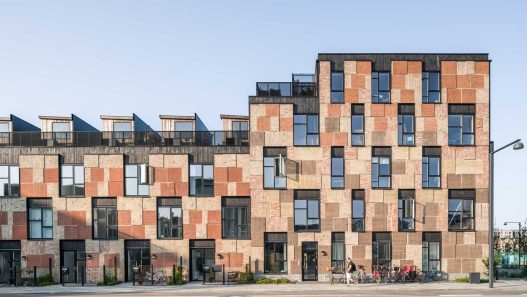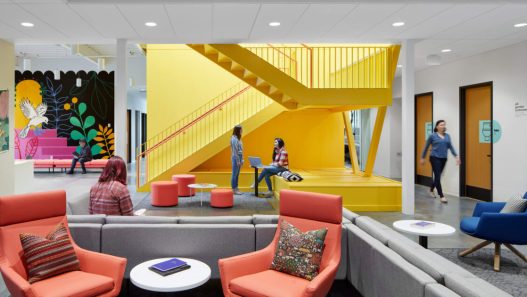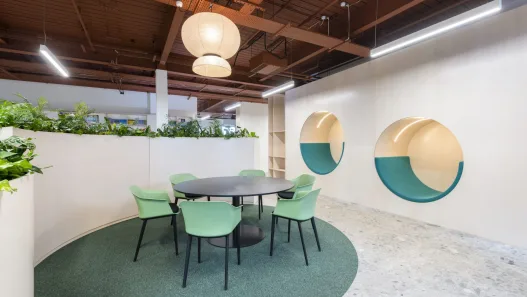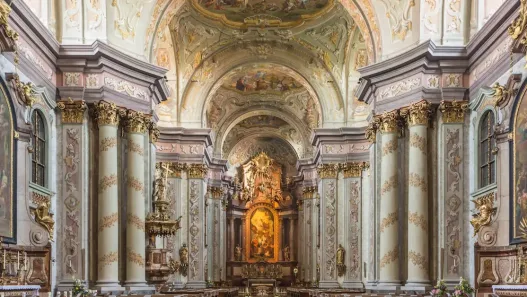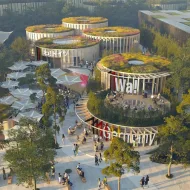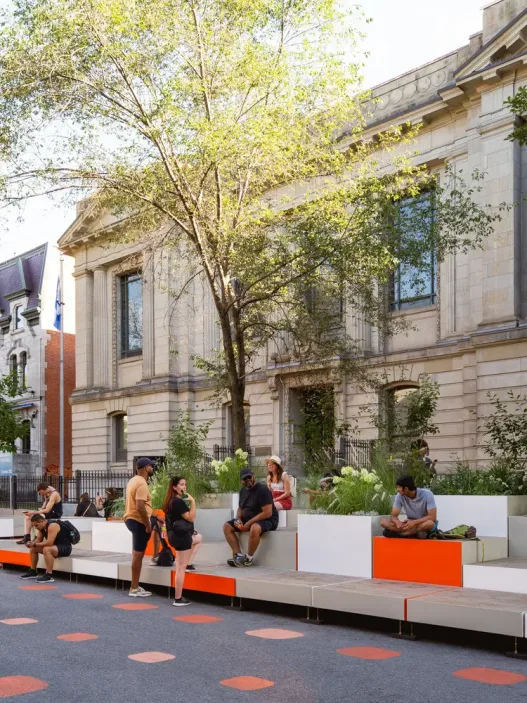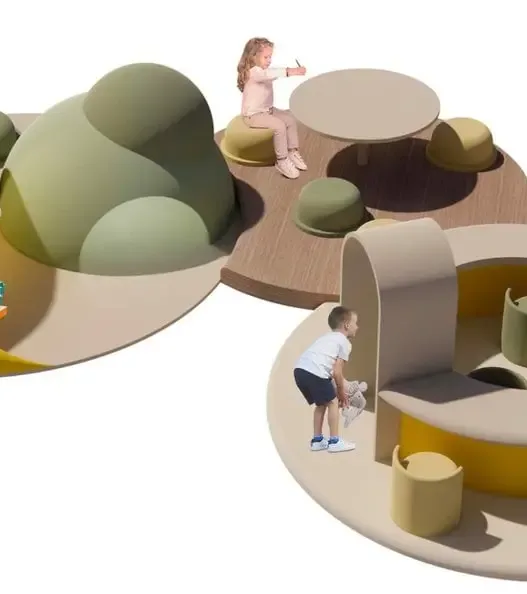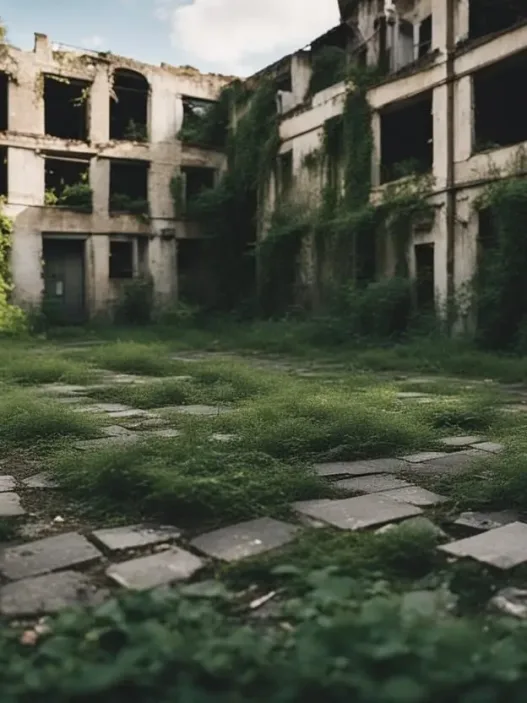Baroque architecture emerged in the late 16th century and flourished until the early 18th century, especially in Europe. This architectural style is famous for its fervour, drama and intricate detail, reflecting the cultural and political changes of its time. The Baroque period was marked by the Catholic Church’s reaction to the Protestant Reformation, leading to a desire for splendour and ostentation in religious and civil buildings. As we explore Baroque architecture, we uncover a world where art and architecture intertwine to create spaces that evoke emotion and awe.
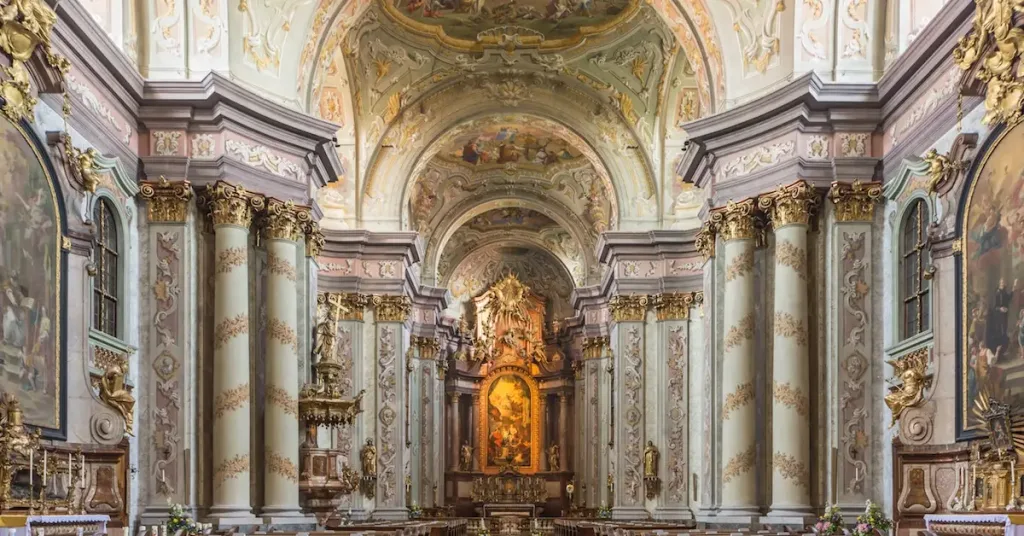
Historical Context
The Baroque period emerged at a time of significant change and transformation. Following the Renaissance, with its focus on symmetry and proportion, the Baroque style broke with these traditions. The Counter-Reformation catalysed this shift as the Catholic Church sought to reassert its influence and attract followers through grandiose and emotionally engaging architecture. The use of bold shapes, dramatic light and vivid colours became a means of conveying religious fervour and authority. During this period, architects such as Gian Lorenzo Bernini and Francesco Borromini played important roles in shaping the Baroque aesthetic and emphasised the connection between architecture and theatricality.
Main Characteristics
Baroque architecture is characterised by its grandeur and boldness. Curvilinear forms, dynamic shapes and complex ornamentation characterise this style. Architects often used light and shadow dramatically, creating a sense of movement that draws the eye throughout the space. The use of domes, towers and broad facades contributed to the overall dramatic effect. The interiors were decorated with frescoes, stuccoes and elaborate sculptures, all designed to elicit emotional responses from the audience. The overall composition aimed to create an integrated experience where architecture, art and space worked together to convey a powerful message.
Influence on Modern Architecture
The influence of Baroque architecture can be seen in various modern structures and design philosophies. Elements such as grand staircases, wide atriums and intricate detailing are common in contemporary buildings that aim to evoke a sense of elegance and opulence. Furthermore, the emphasis on creating a harmonious experience within a space has guided modern architectural practice. While today’s architecture prioritises sustainability and functionality, the Baroque legacy of emotional engagement and aesthetic drama continues to inspire architects and designers around the world.
Cultural Significance
Baroque architecture is not just a style; it is a reflection of the cultural and political landscape of its time. It embodies the tensions between faith and reason, tradition and innovation. Elaborate designs have often served as a canvas for the expression of power, wealth and religious devotion. Structures such as St Peter’s Basilica in the Vatican and the Palace of Versailles in France symbolise the aspirations of their patrons and the societies they represent. These buildings have become cultural landmarks, attracting millions of visitors each year who want to experience their splendour and history.
Overview of Important Buildings
Several iconic buildings exemplify the splendour of Baroque architecture. St Peter’s Basilica, designed by Bernini, is an excellent representation of this style with its magnificent dome and opulent interior. The Palace of Versailles, with its extensive gardens and intricate rooms, displays the power of the French monarchy. In Italy, the Church of San Carlo alle Quattro Fontane, designed by Borromini, features a unique serpentine facade and a stunning interior that plays mesmerisingly with light. These buildings not only emphasise the artistic achievements of the Baroque period, but also serve as enduring symbols of cultural heritage and invite us to reflect on the interplay of art, architecture and society.
As a result, Baroque architecture remains a fascinating subject of study and admiration. Its emotional depth, artistic innovation and cultural significance continue to resonate, reminding us of the powerful role architecture plays in shaping the human experience. As we explore the legacy of Baroque designers, we appreciate not only their technical skill, but also their ability to weave narratives through stone, light and space.
The Baroque period of the 17th and early 18th centuries was a time of extraordinary artistic expression and architectural innovation. Characterised by its dramatic flair, richness and intricate detail, Baroque architecture pushed the boundaries of design, combining art and structure in a way that captivated the senses. This period emerged as a reaction to the Renaissance, emphasising emotional depth and grandeur over the more restrained aesthetic of its predecessor. In this survey, we examine some of the key architects who defined this rich architectural style and each contributed uniquely to the legacy of Baroque design.
Major Baroque Architects
Gian Lorenzo Bernini
Often regarded as the most important figure of Baroque architecture, Gian Lorenzo Bernini was a master of blending architecture with sculpture. Born in Naples, Bernini moved to Rome, where he left an indelible mark on the cityscape. One of his most famous works, St Peter’s Basilica, is a testament to his genius. His design of the great colonnade embracing visitors as they approach the church creates a sense of awe and belonging.
Bernini’s ability to convey emotion through his work is evident in the dramatic use of light and shadow that invites viewers into a narrative. He designed Piazza San Pietro not only as a functional space, but as an experience that draws people into the heart of the Vatican. Bernini’s sculptures, such as “The Assumption of St Teresa”, further exemplify his ability to capture movement and emotion, making him one of the cornerstones of Baroque art.
Francesco Borromini
A contemporary of Bernini, Francesco Borromini is known for his innovative approach to architectural form and space. Born in 1599, Borromini’s works are characterised by their bold geometry and complex spatial dynamics. In contrast to Bernini’s emphasis on grandeur, Borromini created buildings that challenged traditional architectural norms by focusing on the interaction of light and space.
One of his most important contributions is the Church of San Carlo alle Quattro Fontane in Rome. Here Borromini used a dynamic façade that curves and undulates, drawing the eye and creating a sense of movement. His use of intricate patterns and layered forms challenges the viewer’s perception, making his buildings feel alive. Borromini’s influence extended beyond his time, inspiring generations of architects to experiment with form and function in innovative ways.
Pietro da Cortona
Pietro da Cortona, another important figure of the Baroque period, was famous for his ability to integrate painting and architecture. Born in 1596, Cortona is best known for his work on the Palazzo Barberini, a magnificent example of Baroque domestic architecture. His designs often feature elaborate frescoes that extend beyond the boundaries of the walls, creating a seamless dialogue between interior and exterior spaces.
Cortona’s style is notable for its theatricality, often featuring grand staircases and wide open spaces that invite exploration. Cortona’s work exemplifies the Baroque desire to engage the viewer by creating environments that stimulate the senses. The use of light in Cortona’s designs enhances dramatic effects, making his spaces not only visually appealing but also emotionally resonant.
Andrea Palladio
Although Andrea Palladio is primarily associated with the Renaissance, his influence on Baroque architecture cannot be ignored. Born in 1508, Palladio’s principles of symmetry and proportion laid the groundwork for many Baroque architects. His villas and palaces, such as Villa Rotonda, display a harmonious blend of classical elements with an emerging Baroque flair.
Palladio’s emphasis on symmetry and his innovative use of porticos and columns inspired Baroque architects to explore these elements in more dramatic ways. Palladio’s work had a lasting impact and led to the development of the Palladian style, which became the basis for much Baroque design. His ability to combine functionality and beauty set a precedent that many Baroque architects would follow, and his influence reverberated throughout the period.
Louis Le Vau
Louis Le Vau, one of the leading French architects of the Baroque period, is best known for his work on the Palace of Versailles. Born in 1612, Le Vau’s designs reflect the splendour and wealth of the French monarchy. His innovative approach to the layout of the palace transformed it into a symbol of royal power and prestige.
Le Vau’s mastery of space is evident in the way he organised the gardens and the complex interplay of interior and exterior spaces. The grand staircase and the Hall of Mirrors create a sense of spaciousness that is both awe-inspiring and inviting, demonstrating Le Vau’s ability to manipulate light and space. His works not only defined the architectural landscape of France, but also set the standard for royal architecture throughout Europe, demonstrating the enduring legacy of Baroque design.
The Baroque period was a remarkable period of architectural innovation, with each of these architects contributing a rich tapestry of creativity. Transforming the built environment with their distinctive styles and approaches, they left a legacy that continues to inspire and fascinate us today. Each building tells a story of ambition, art and human spirit that invites the discovery and appreciation of the drama and splendour that define Baroque architecture.
The Baroque period was a period of extravagant creativity in architecture, stretching from the late 16th to the early 18th century. It emerged as a reaction to the simplicity of the Renaissance, embracing emotional intensity and richness. Baroque designs are characterised by their dramatic flair, intricate detail and deep connection to the cultural changes of the time. This period produced some of the most striking architectural masterpieces that continue to be admired today.
Basic Elements of Baroque Design
The essence of Baroque architecture lies in its unique elements that combine to create an experience that transcends mere structure. Each feature contributes to the overall narrative of grandeur and emotion that defines this style.
Use of Light and Shade
In Baroque architecture, light is not only a functional element; it plays a crucial role in creating atmospheric drama. Designers skilfully manipulated natural light through large windows, strategic openings and ornate ceilings. This interplay of light and shadow adds depth and texture to spaces, enhancing the emotional impact of interiors. For example, the use of chiaroscuro – the contrast of light and dark – has been popularised by both artists and architects. An excellent example of this can be seen in the interiors of St Peter’s Basilica in the Vatican, where the interplay of light emphasises the intricate details of the sculptures and frescoes. The dance of light on surfaces not only revitalises the space, but also evokes a sense of spirituality and wonder.
Fancy Decoration
Ornamentation is the hallmark of Baroque design. In contrast to the restrained elegance of earlier styles, Baroque architects adopted lavish ornamentation adorning facades and interiors. This included elaborate sculpture, intricate mouldings and gilded accents. The use of symbolic motifs often carried deeper meanings, reflecting the values and beliefs of the period. The Palace of Versailles in France exemplifies this richness, with its grand halls decorated with gold leaf, crystal chandeliers and intricate tapestries. Each decorative element tells a story, inviting viewers to appreciate the craftsmanship and artistry that went into creating these magnificent spaces.
Dynamic Forms
Baroque architecture is famous for its dynamic forms that move away from traditional straight lines and rigid structures. Curved walls, sweeping staircases and undulating facades create a sense of movement and fluidity. This approach reflects the Baroque fascination with drama and emotion and gives buildings a lively, almost theatrical quality. The Church of San Carlo alle Quattro Fontane in Rome is a prime example of this dynamic approach, with its undulating facade that seems to ripple and flow. Such designs are not only pleasing to the eye, but also embody the spirit of the period, evoking feelings of excitement and energy.
Large Scale and Proportions
The splendour of Baroque architecture is often expressed in its monumental scale. Buildings were designed to impress with their high ceilings, spacious halls and colossal columns. This sense of scale was not just for show; it was intended to inspire awe and respect. The use of exaggerated proportions created a visual effect that reinforced the power and prestige of the institutions that commissioned these works, such as the Catholic Church and royal palaces. The Basilica of Santa Maria della Salute in Venice, with its large dome and wide portico, exemplifies this principle and stands as a testament to human ambition and creativity.
Integration with its surroundings
Baroque designers were keenly aware of the relationship between their buildings and the landscape around them. Rather than isolating buildings, they sought to create harmonious connections with their surroundings. This integration often included carefully planned gardens, landscapes and urban layouts that enhanced the architectural experience. The gardens of the Palace of Versailles, for example, are a striking extension of the palace and were designed to reflect the grandeur and symmetry of the building while providing a lush, serene escape. This thoughtful integration creates a dialogue between nature and architecture, inviting visitors to explore and meaningfully interact with the space.
As a result, the architectural heritage of the Baroque period is rich with elements that continue to inspire and captivate. The use of light and shadow, ornate decoration, dynamic forms, grand scale and careful integration with the environment all contribute to the drama and splendour of this extraordinary period. Each building tells a story and invites us to step into a world where architecture becomes a splendid expression of creativity and emotion.
The Baroque period, spanning the 17th and 18th centuries, is famous for its dramatic, ornate style that transformed architecture into a theatrical experience. The period was characterised by the desire to evoke emotion and awe through grand designs, intricate detailing and the play of light and space. Architects and designers sought to create structures that not only served a purpose but also told a story, embodying the power and wealth of the church and the ruling classes.
Iconic Baroque Buildings
Baroque architecture is characterised by its bold forms, elaborate ornamentation and sense of movement. Among the many splendid works of this period, a few buildings stand out as icons of Baroque design, each displaying the unique vision of their creators.
St Peter’s Basilica
St Peter’s Basilica in Vatican City is perhaps the most famous example of Baroque architecture. Designed by a number of famous architects, including Michelangelo and Bernini, the basilica is a masterpiece of splendour. Its colossal dome, dominating the skyline, was a groundbreaking feat of engineering. The interior of the basilica is adorned with lavish decorations, including stunning mosaics and intricate sculptures that inspire a sense of the divine. The light utilised through strategically placed windows creates an ethereal atmosphere that invites visitors on a spiritual journey. St Peter’s Basilica serves not only as a place of worship, but also as a symbol of the power of the Catholic Church in the Baroque period.
Palace of Versailles
Located just outside Paris, the Palace of Versailles exemplifies the richness of the Baroque style in France. Originally a hunting lodge, it was transformed into a grand palace under the rule of Louis XIV. The palace features extensive gardens, ornate fountains and meticulously designed interiors that reflect the splendour of the French monarchy. The Hall of Mirrors, with its dazzling chandeliers and reflective surfaces, is a particularly iconic structure, showcasing the interplay of light that is the hallmark of Baroque design. Versailles was not just a royal residence; it was an expression of power and a centre of political life, where art and architecture were used to convey the king’s divine right to rule.
Royal Palace of Madrid
In Spain, the Royal Palace of Madrid stands as a testament to Baroque architecture. Designed by architects such as Juan Bautista Sachetti and Francesco Sabatini, this majestic structure has a mixture of classical and Baroque elements. The exterior of the palace is adorned with sculptures and intricate details that reflect the wealth of Spanish royalty. Inside, the opulent rooms are filled with works of art, gilded decorations and luxurious furnishings that showcase the opulence of royal life. The Royal Palace not only serves as the official residence of the Spanish royal family, but also houses a museum that preserves the rich history of the Spanish monarchy.
Schönbrunn Palace
The Schönbrunn Palace in Vienna is another remarkable example of Baroque architecture. Originally a hunting lodge, it was expanded into a grand palace during the reign of Empress Maria Theresa. The palace is surrounded by beautifully landscaped gardens with fountains, statues and a labyrinth designed to impress visitors. Inside the palace are opulent rooms filled with elegant furnishings and works of art that reflect the Habsburgs’ lifestyle. Schönbrunn Palace demonstrates the connection between architecture and nature; the gardens are as meticulously designed as the interiors, creating a harmonious environment that mesmerises all who visit.
Church of San Carlo alle Quattro Fontane
The Church of San Carlo alle Quattro Fontane in Rome, designed by Francesco Borromini, is a striking example of Baroque innovation. Its unique elliptical shape and dynamic façade create a sense of movement and fluidity, breaking with traditional rectangular designs. The interior is equally mesmerising, with intricate stucco work and the play of light enhancing the spiritual experience. This church reflects Borromini’s genius for manipulating space and form and demonstrates how Baroque architecture can evoke a deep emotional response.
In conclusion, the iconic buildings of the Baroque period encapsulate the drama and splendour that defined this extraordinary architectural movement. Each building tells a story of power, faith and art, inviting us to explore the intricate details and sumptuous designs that continue to amaze today. Whether the soaring domes of cathedrals or the opulent halls of palaces, Baroque architecture remains a testament to human creativity and ambition and invites us to appreciate the beauty of the past.
The Role of Sculpture in Baroque Architecture
The Baroque period was a period of exuberance and dramatic expression in art and architecture that flourished from the late 16th to the early 18th century. Characterised by grandeur, movement and emotional intensity, Baroque architecture sought to impress the viewer not only visually but also emotionally. At the centre of this fascinating style is sculpture, which plays a crucial role in developing the architectural narrative. The integration of sculptural elements transformed buildings into dynamic spaces that tell stories, evoke emotions and celebrate the divine.
Integration of Sculptural Elements
In Baroque architecture, sculpture is not just an add-on, but an integral part of the architectural composition. Facades are adorned with intricate sculptures that seem to burst from the walls, creating a sense of movement and drama. The use of reliefs, sculptures and ornate ornamentation breaks up the solid surfaces of the buildings, allowing them to interact with light and shadow. This three-dimensionality enhances the viewer’s experience as the sculptures invite closer scrutiny and reflection. The integration of these elements often reflects the themes of the building, whether religious, civic or commemorative.
For example, Gian Lorenzo Bernini made extensive use of sculptural elements in the design of St Peter’s Basilica in the Vatican. The large colonnade surrounding the piazza creates an inviting embrace, while the towering statues of saints at the top of the basilica remind visitors of the spiritual significance of the site. This seamless blend of architecture and sculpture creates an immersive environment that draws people into a deeper relationship with the space.
Important Sculptors
The Baroque period witnessed the rise of many influential sculptors who left an indelible mark on the architectural landscape. Gian Lorenzo Bernini stands out as a central figure, known for his ability to infuse life and emotion into marble. His works, such as the dramatic “Assumption of St Teresa”, display the spiritual intensity characteristic of the Baroque style. Another important name is Francesco Borromini, whose architectural designs often incorporate sculptural details that complement his innovative forms.
In addition, artists such as Alessandro Algardi and Giovanni Battista Foggini made important contributions to the Baroque aesthetic by producing works that enhanced the splendour of churches and public buildings. His sculptures often depicted biblical scenes or allegorical figures, reinforcing the thematic elements of the architecture they adorned.
Symbolism in Sculpture
Symbolism plays a vital role in Baroque sculpture, with many works designed to convey deeper meanings and narratives. The figures depicted often represent virtues such as faith, charity and justice, and serve not only as decorative elements but also as moral reminders for the viewer. This symbolic approach is particularly evident in religious buildings, where statues of saints and angels are strategically placed to inspire devotion and reverence.
In Bernini’s work, for example, the use of light often emphasises particular statues, drawing attention to their significance. The illuminated figures can be seen as channels between the mundane and the divine, forming a bridge for worshippers. This elaborate installation and symbolic representation enriches the viewer’s experience, inviting contemplation and reflection.
Case Studies of Sculptural Works
Examining specific examples of Baroque sculptural works reveals the profound impact of this art form on architecture. One exemplary case is the Trevi Fountain in Rome, designed by Nicola Salvi. The grand fountain features a stunning array of sculptures, including the central figure of Oceanus, who commands the waters. The dynamic poses and flowing drapery of the figures create a sense of movement that captivates onlookers.
Another notable example is the façade of the Church of San Carlo alle Quattro Fontane, designed by Borromini. The intricate reliefs and sculptures that adorn the church evoke a sense of fluidity, perfectly complementing the building’s undulating forms. These case studies illustrate how sculptural works not only enhance the physical space but also contribute to the overall narrative and emotional impact of the architecture.
Impact on Architectural Aesthetics
The influence of sculpture on Baroque architecture extends beyond individual buildings; it shaped the aesthetics of the period. The dramatic interplay between sculpture and architecture encouraged a more expressive approach to design, setting a precedent for future styles. The Baroque emphasis on movement, emotion and grandeur paved the way for later architectural movements such as Rococo, which further explored these themes.
Moreover, the collaborative nature of Baroque projects, with architects and sculptors working together, provided a model for interdisciplinary collaboration in the arts. This legacy continues to inspire contemporary architects and artists who recognise the power of integrating different art forms to create engaging spaces.
In conclusion, the role of sculpture in Baroque architecture is a testament to the period’s commitment to drama and splendour. Through the integration of sculptural elements, the contributions of important sculptors and the rich symbolism contained in their works, Baroque architecture goes beyond mere construction to become a profound expression of human emotion and creativity. The legacy of this interaction continues to resonate in the world of architecture, reminding us of the enduring power of art to shape our experience.
6. The Legacy of Baroque Architecture
The Baroque period developed from the late 16th to the early 18th century, leaving an indelible mark on the world of architecture. Characterised by its dramatic flair, elaborate details and sense of movement, Baroque architecture changed the way spaces were designed and perceived. This legacy manifests itself in a variety of ways, from influencing future architectural styles to inspiring contemporary design, demonstrating the lasting impact of this rich period.
Influence on Later Architectural Styles
The Baroque style is a cornerstone in the evolution of architecture and has influenced countless subsequent movements. Its emphasis on exaggerated ornamentation and splendour set the stage for Neoclassicism, which sought to revive the classical ideals of ancient Rome and Greece in a more restrained approach. Architects such as Andrea Palladio and later architects of the Romantic period were inspired by Baroque elements, integrating dramatic scale and bold contrasts into their work.
The emotional resonance found in Baroque architecture also influenced the development of styles such as Rococo, which emerged in the 18th century. Rococo focused on asymmetry and elaborate ornamentation, taking the subtleties of the Baroque and applying them in a more playful and often lighter manner. This lineage shows how the Baroque’s emphasis on emotion and splendour permeated the architectural landscape and continued to inspire designers for centuries.
Conservation and Restoration Works
As with any important art movement, the preservation of Baroque architecture has become a vital endeavour. Many Baroque buildings, rich in history and art, have been threatened by urban development, neglect and natural disasters. Conservation efforts have gained momentum as organisations and governments have recognised the cultural value of these buildings.
Restoration projects often aim to restore buildings to their former splendour, respecting their historic context. Techniques combining traditional craftsmanship with modern technology have evolved, ensuring the preservation of the intricate details characteristic of Baroque architecture. These efforts not only preserve the architectural heritage, but also serve to educate future generations about the artistic and cultural significance of this period.
Baroque Elements in Contemporary Design
The splendour of Baroque architecture continues to inspire contemporary designers who combine its elements in a variety of innovative ways. References to the Baroque can be found in modern buildings, using bold curves, dramatic facades and a play of light and shadow that evokes the same emotional responses that Baroque architects intended.
Many luxury hotels, theatres and museums adopt Baroque-inspired designs to evoke a sense of opulence and refinement. For example, the opulent interiors of some high-end establishments may include elaborate mouldings, grand staircases and intricate chandeliers reminiscent of Baroque palaces, creating an atmosphere that transports visitors to a different era.
The Global Spread of Baroque Architecture
The Baroque style spread all over the world, transcending its European origins and adapting to local cultures. In Latin America, for example, Baroque architecture gained unique characteristics by blending indigenous elements with European influences. The result is striking churches and government buildings that reflect a rich cultural tapestry.
In Asia, Baroque influences can be seen in ornate temples and palaces that reflect its dramatic style. The blending of local architectural traditions with Baroque principles demonstrates the versatility of the style and its ability to resonate with various cultures. This global spread emphasises not only the adaptability of Baroque architecture, but also its role in promoting intercultural exchange during the colonial period.
Enduring Glamour
The enduring appeal of Baroque architecture lies in its ability to evoke emotion and create awe-inspiring spaces. The legacy of Baroque architecture continues to shape not only the physical environment, but also the way we understand and appreciate art and architecture. The drama and splendour of Baroque buildings invite us to explore the past and inspire contemporary expressions of creativity.
As we look to the future, the lessons of the Baroque era remind us of the power of architecture to connect us to our history and culture. Whether through conservation efforts, contemporary reinterpretations, or the global dissemination of its principles, the influence of Baroque architecture remains a living thread woven into the fabric of our built environment.



